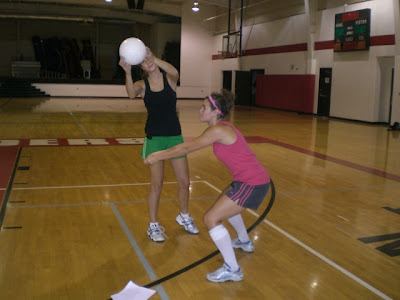* Always face and make sure your hips are square to the server/attacker.
* Move in the ready position by shuffling your feet. You want to make sure that you stay low, balanced and as stable as possible. You should not be moving up and down with each shuffle step. Keep your head in and track the ball with your eyes the entire time.
* ANGLE OF DEFLECTION = TRAJECTORY OF PASS: Angle your platform by dropping your shoulder to deflect the ball to the setter
(do not move your hips or body to face the setter... this will result in a shanked ball!). Present your platform EARLY (LONG before the ball reaches you)!

* CONTACT: Contact the ball on your upper wrists/forearms (not your thumbs or lower wrists). When you contact the ball, you will NOT swing with your arms.
At most your platform will move up 2". In some cases, you should actually move your platform down to absorb some of the energy so that the pass isn't too high on a hard hit ball. On contact, maintain that same ready, stable position.
Mistakes I see often are girls that push their butts out on contact, stand up on contact, lift their head or bend their elbows when they pass. You should move the ball to the target with your LEGS & HIPS (not your arms), by shuffling through the pass.

* AFTER MOVEMENT: After the ball touches your platform, KEEP SHUFFLING THROUGH THE PASS!
This gives you much better accuracy and prevents a lot of mistakes such as stabbing at balls. Aim to shuffle your feet at least 2 more steps AFTER the ball has left your arms! AND during those two shuffle steps, keep your platform out and stable, in the same position it was in when you passed the ball!

 * Bend at the ankles and have your weight on the balls of your feet (heels should still touch the floor). Your platform should be parallel to your thighs and your back should be parallel to your calves. Feet are shoulder-width apart.
* Bend at the ankles and have your weight on the balls of your feet (heels should still touch the floor). Your platform should be parallel to your thighs and your back should be parallel to your calves. Feet are shoulder-width apart.

 * CONTACT: Contact the ball on your upper wrists/forearms (not your thumbs or lower wrists). When you contact the ball, you will NOT swing with your arms. At most your platform will move up 2". In some cases, you should actually move your platform down to absorb some of the energy so that the pass isn't too high on a hard hit ball. On contact, maintain that same ready, stable position.
* CONTACT: Contact the ball on your upper wrists/forearms (not your thumbs or lower wrists). When you contact the ball, you will NOT swing with your arms. At most your platform will move up 2". In some cases, you should actually move your platform down to absorb some of the energy so that the pass isn't too high on a hard hit ball. On contact, maintain that same ready, stable position.  * AFTER MOVEMENT: After the ball touches your platform, KEEP SHUFFLING THROUGH THE PASS!
* AFTER MOVEMENT: After the ball touches your platform, KEEP SHUFFLING THROUGH THE PASS! 
























 Bend the opposite knee and roll up on that leg. Stand up and get back into ready position.
Bend the opposite knee and roll up on that leg. Stand up and get back into ready position.
